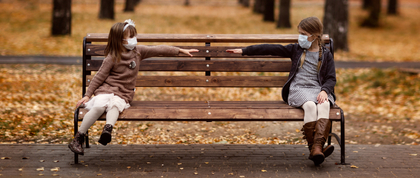
So, are we ready to get a little closer? Last week the Centers for Disease Control and Prevention released revised guidelines for social distancing in classrooms. In brief, they advise:
- Elementary schools: all students remain at least 3 feet apart in classrooms where mask use is universal — regardless of whether community transmission is low, moderate, substantial, or high
- Middle and high schools where transmission is low, moderate, or substantial: Students should be at least 3 feet apart in classrooms where mask use is universal.
- Middle school students and high schools where transmission is high: Students should be at least 6 feet apart, if cohorting (i.e., groups of students are kept together with the same peers and staff throughout the school day) is not possible.
The WHO recommends distances of at least one meter (~3.3 feet), and the CDC’s new recommendations bring our country somewhat in line with these international guidelines. There are studies that suggest secondary transmission within schools in the U.S. is low where there is masking and social distancing.
But the evidence for 3 feet social distancing is currently weak, and studies with stronger methods that explicitly address distance as a risk factor for classroom transmission are still needed.
The one thing that is predictable about the pandemic is that recommendations evolve as more data becomes available. Until then, among the evidence for these new guidelines includes five peer-reviewed studies:
One study examined all cases reported to the Florida Department of Health and found 695 school-based outbreaks in 93% of 67 school districts and 10.2% of 6800 schools from August 10–December 21, 2020. There were 4,370 total cases in Florida primary and secondary schools;
The second study in Utah examined COVID transmission in elementary schools from December 3, 2020 to January 31, 2021 in a convenience sample of 20 elementary schools. Among 1041 susceptible school contacts (students and staff members exposed to COVID in school of 51 index patients), 735 (70.6%) were tested for COVID with a PCR test. Of the 12 identified cases, 5 associated with a school resulting in a secondary attack rate of 0.7%. Of note, mask use among students was 86% and the median distance between students’ seats in classrooms was 3 ft.
The third study examined transmission in a boarding high school in New Jersey among 520 full-time resident students, 255 commuter students, and 405 faculty and staff members. The schools’ pandemic strategy included universal masking, mandatory PCR testing twice per week, upgraded air-handling equipment to improve ventilation, physical distancing of ≥6 ft, contact tracing, and quarantine and isolation protocols. From August 20 to November 27, 2020 21,449 specimens were tested; 19 (5%) of faculty and staff members and 8 (1%) students tested positive with only 2 cases linked to on campus transmission.
A fourth study was an ecological analysis of transmission in schools in Massachusetts and found that COVID rates among students were similar in the 242 districts with ≥3 feet versus ≥6 feet of physical distancing between students. A fifth study found low secondary transmission in 11 North Carolina school districts during the first 9 weeks of in-person instruction in the 2020–2021 academic year. Over 9 weeks, among the >90 000 students and staff that attend school in person, 773 community-acquired COVID cases were detected with an additional 32 infections acquired within schools.
The data on social distancing should be considered with a few caveats – the Utah study reported median social distances less than 6 feet but did not analyze distance as a risk factor for transmission, the North Carolina study can only be interpreted at the district level, and case ascertainment in Florida and Massachusetts may be incomplete as it is based on reported cases. Thus, in Utah and North Carolina where social distancing was considered, it is unclear whether cases were among those who were more likely to be in closer proximity to others in the school setting.

Danielle Ompad, PhD
Associate Dean for Education;
Associate Professor of Epidemiology

Holly Hagan, PhD
Director of NIDA P30 CDUHR;
Professor of Global Public Health